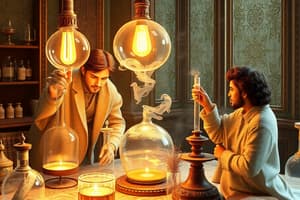Podcast
Questions and Answers
Which of the following defines an independent variable in an experiment?
Which of the following defines an independent variable in an experiment?
- The variable that is changed based on the controlled variables.
- The variable that is measured as the outcome of the experiment.
- The variable that is kept constant throughout the experiment.
- The variable that is manipulated by the experimenter. (correct)
What is a characteristic of a good scientific question?
What is a characteristic of a good scientific question?
- It should focus clearly on an independent and dependent variable. (correct)
- It should only seek verification of existing theories.
- It should be broad with many possible answers.
- It should be subjective and based on personal opinions.
What role do controlled variables play in an experiment?
What role do controlled variables play in an experiment?
- They assess the validity of the experiment. (correct)
- They are the variables that scientists manipulate.
- They are the primary focus of the experiment.
- They introduce additional change to the dependent variable.
In the context of scientific experiments, what does a dependent variable represent?
In the context of scientific experiments, what does a dependent variable represent?
Confounding variables in an experiment are best described as:
Confounding variables in an experiment are best described as:
How can scientific questions typically be categorized?
How can scientific questions typically be categorized?
Which axis is typically used to represent the independent variable in a graph?
Which axis is typically used to represent the independent variable in a graph?
What is the purpose of control variables in an experiment?
What is the purpose of control variables in an experiment?
What distinguishes a positive control group from a negative control group?
What distinguishes a positive control group from a negative control group?
What aspect of a scientific experiment is meant to provide objective results?
What aspect of a scientific experiment is meant to provide objective results?
Which of the following is NOT a component of a good argumentative essay?
Which of the following is NOT a component of a good argumentative essay?
What does the CER acronym stand for in scientific writing?
What does the CER acronym stand for in scientific writing?
Which of the following strategies should you use when interpreting complex tables during tests?
Which of the following strategies should you use when interpreting complex tables during tests?
What do scientists achieve by following the scientific method?
What do scientists achieve by following the scientific method?
Which type of data visualization is most effective for showing changes over time?
Which type of data visualization is most effective for showing changes over time?
What does a negative control group aim to establish?
What does a negative control group aim to establish?
What is a hypothesis primarily characterized as?
What is a hypothesis primarily characterized as?
What is a key difference between a scientific law and a scientific theory?
What is a key difference between a scientific law and a scientific theory?
Which characteristic is NOT essential for models to be successful?
Which characteristic is NOT essential for models to be successful?
How do simulations primarily contribute to scientific processes?
How do simulations primarily contribute to scientific processes?
What defines a scale model?
What defines a scale model?
What is the main purpose of conceptual models?
What is the main purpose of conceptual models?
What role do models and simulations play in education?
What role do models and simulations play in education?
Which of the following statements about physical models is true?
Which of the following statements about physical models is true?
Which of the following accurately describes organic molecules?
Which of the following accurately describes organic molecules?
Flashcards are hidden until you start studying
Study Notes
Scientific Questions and Experiments
- Designing scientific questions is crucial for effective inquiry and learning.
- Scientific questions fall into verification, theory, or experimental categories.
- Characteristics of good scientific questions include objectivity, testability, and a clear focus on independent and dependent variables.
- Scientific experiments follow the scientific method involving observation, measurement, experimentation, and hypothesis revision.
- Key variables in experiments:
- Independent variables (manipulated)
- Dependent variables (measured outcomes)
- Controlled variables (kept constant)
Types of Variables
- Independent variable is labeled as 'x' (often on the x-axis).
- Dependent variable is labeled as 'y' (usually on the y-axis).
- Confounding variables can influence the relationship between independent and dependent variables.
- Extraneous variables encompass all factors affecting the dependent variable.
- Control variables minimize potential confounders, ensuring experimental reliability.
Experimental Design
- Experiments consist of control groups and test groups.
- Control groups have no treatment or receive a known treatment for comparison.
- Test groups receive novel treatments to measure responses.
- Positive controls trigger a known response; negative controls aim to eliminate unexpected variables (e.g., placebos).
Historical Experiments
- Frederick Griffith discovered a transforming principle in bacteria; Oswald Avery identified DNA as the basis for this transformation.
- Avery's method involved meticulous control of variables to yield objective 'yes or no' results.
Problem Solving Techniques
- For table and chart problems, first scan the table/data before reading questions.
- Understand the concepts behind data; formulate answers independently of the choices provided.
- In charts, note x- and y-axes, identify trends, and interpret line shapes before addressing questions.
Data Visualization
- Organizing data aids analysis; various visualizations are suited for specific data types.
- Bar graphs for discrete categories, line graphs for trends over time, and pie charts for parts of a whole are common formats.
Argumentative Essays and CER
- An argumentative essay presents a claim, supported by reasons, evidence, and counterclaims.
- The format includes an introduction, multiple body paragraphs, and a conclusion.
- The CER (Claim, Evidence, Reasoning) method structures arguments: a claim is supported with factual evidence and reasoning clarifies connections.
Scientific Method
- Steps include observation, question formulation, research, hypothesis creation, experimentation, analysis, and conclusion.
- A hypothesis can be tested; a scientific theory gains acceptance through extensive evidence.
- Scientific laws are absolute and universally valid statements, usually mathematical.
Models and Simulations
- Models visualize systems and enhance understanding of complex concepts.
- Simulations recreate real-world scenarios, providing a safe environment for experimentation.
- Steps for conducting simulations include scenario identification, objective determination, model development, testing, and execution.
Organic Molecules
- Composed of carbon with hydrogen, oxygen, and nitrogen; four classes: carbohydrates, lipids, proteins, nucleic acids.
- Carbohydrates are energy-producers, lipids serve in energy storage, proteins provide structural functions, nucleic acids store genetic information.
- Carbon's bonding characteristics lead to various functional groups, influencing properties and interactions.
Carbohydrates
- Made of carbon, hydrogen (twice in number to oxygen), and oxygen combinations.
- Building blocks include saccharides:
- Monosaccharides (one unit)
- Disaccharides (two units)
- Oligosaccharides (three to ten units)
- Polysaccharides (more than ten units, storing energy).
- Starch and glycogen are energy storage forms; cellulose serves as dietary fiber.
- Carbohydrates are hydrophilic, facilitating easy absorption into the bloodstream.
Studying That Suits You
Use AI to generate personalized quizzes and flashcards to suit your learning preferences.





